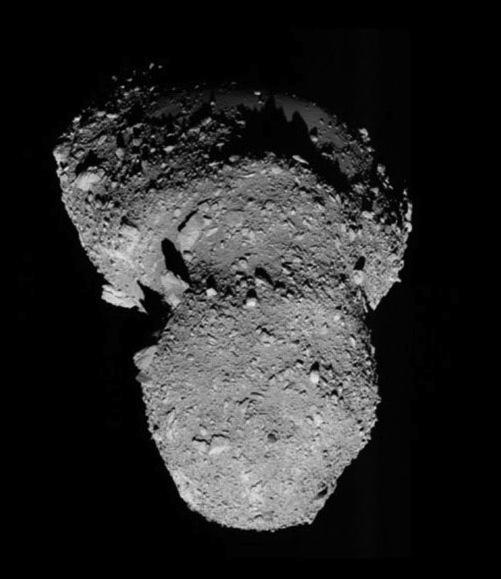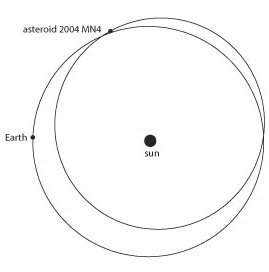 Above is a computer generated image of the asteroid 99942 Apophis. Readers will know that the British Gazette is critical of these greenies in claiming that human life of the planet is endangered by human CO2 emissions. There are of course many good reasons why we should object to the CO2 scam as this will cause many poor and elderly people to suffer needlessly.
Above is a computer generated image of the asteroid 99942 Apophis. Readers will know that the British Gazette is critical of these greenies in claiming that human life of the planet is endangered by human CO2 emissions. There are of course many good reasons why we should object to the CO2 scam as this will cause many poor and elderly people to suffer needlessly.
There are however more important reasons. Firstly there is the crying wolf argument. It is a very dangerous act of public policy to flag up as a danger something that is not for you will only secure the distrust of the general public. This is very dangerous as there are very real dangers that have to be considered and eventualities planned for.
In our 28th September article, 2010 ST3: A near miss We reported upon this lump of space rock coming within 4 million miles of earth in mid October. There is however a much larger lump of space rock which is over 1,000 feet across and is due to pass closer to the earth than the geo-synchronous satellites that orbit the earth.
This lump of rock has a name: Apophis. Apophis is named after the Egyptian mythological serpent of ancient Egypt. Called the Serpent of Chaos Apophis is said to have fought the cat goddess Bastet fought for millennia.
On Friday, 13th April 2029 it will come within18,300 miles, (5.6 Earth radii from the centre, or 4.6 Earth-radii from the surface). It will appear over the mid-Atlantic, appearing to the naked eye as a moderately bright point of light moving rapidly across the sky. Depending on its mechanical nature, it could experience shape or spin-state alteration due to tidal forces caused by Earth’s gravity field.
Apophis will approach the earth again in 2036. NASA state that new measurements possible in 2013 (if not 2011) will likely confirm that in 2036 Apophis will quietly pass more than 49 million km (30.5 million miles; 0.32 AU) from Earth on Easter Sunday of that year (13th April).
There is of course a remote possibility that Apophis could impact the Earth. Apophis has an orbit slightly offset orbit to that of Earth’s. Discovered in June 2004, the exact path the asteroid follows on its flyby in 2029 will determine whether it smashes into the Earth seven years later.
Apophis has an orbit slightly offset orbit to that of Earth’s. Discovered in June 2004, the exact path the asteroid follows on its flyby in 2029 will determine whether it smashes into the Earth seven years later.
In 2004, it was first thought that the asteroid would hit us in the first flyby in 2029. The initial calculation for the orbit was made using only two sets of observations, those made in June and a subsequent set made in December. From those observations, astronomers calculated a 1-in-200 chance that the asteroid would hit the Earth. After taking more observations , the chances climbed even higher and by the end of December 2004, the chances of the Earth being struck by this asteroid climbed as high as 1-in-37. Later, some other observations from other sources were located and they allowed astronomers to calculate a more precise orbit. From those images they were able to conclude that there was no way that Apophis was going to hit the Earth.
We’re not out of the woods yet. As you may know, when one celestial object passes close to another one, their orbits are altered a bit by the gravitational forces interacting between the two bodies. Since Apophis is much smaller than the Earth (1,050 feet- across), its orbit will be the one affected. As it flies by the Earth, its orbit will be altered. After astronomers had determined that the April 2029 encounter wasn’t going to impact the Earth, they ran some simulations and found that the orbit of the asteroid will bend about 28 degrees, altering its course.
The flyby will make the orbit a bit bigger and Apophis will travel a bit slower. How much the orbit changes depends on how close it gets to us. If it flies through a specific three furlong wide region of space as it goes past us in 2029, then Apophis and the Earth will be in the exact same spot 7 years later on Friday 13th April, 2036 – which happens to be Easter Sunday. In these circumstances, definitely NOT a happy Easter.
The odds of Apophis passing through that region of space the width of only thirty cricket pitches is 48,000:1 Compare that with the odds of 76,275,360:1 of you winning the Euromillions Lottery. That is to say that it is 15,897 times more likely that Apophis will srike the Earth on Easter Sunday 2036 that you have of winning the Euromillions Lottery – were you to buy a ticket of course!!
This sort of impact has happened before. It is widely believed that such an impact by an asteroid is responsible for changing the Earth in such a way as to adversely affect the dinosaurs, wiping them out. Also, The Tunguska Event is believed to be an explosion of a meteorite in the air above Siberia.
There are all sorts of objects like Apophis whirling over our heads. There is a real chance that the Earth can be struck by an asteroid we haven’t seen yet. Because they are so small, they are dim and are easily missed by our telescopes.
NB: Much of the above (sans comments) has been copied from the sources below:
http://neo.jpl.nasa.gov/apophis/
http://www.deepastronomy.com/apophis-asteroid-could-hit-earth.html
Speaking the Truth unto the Nation
